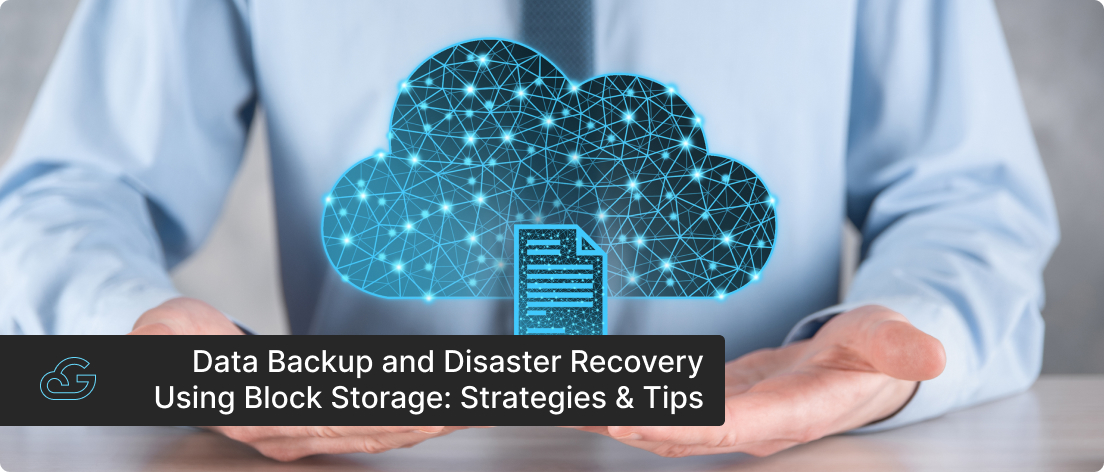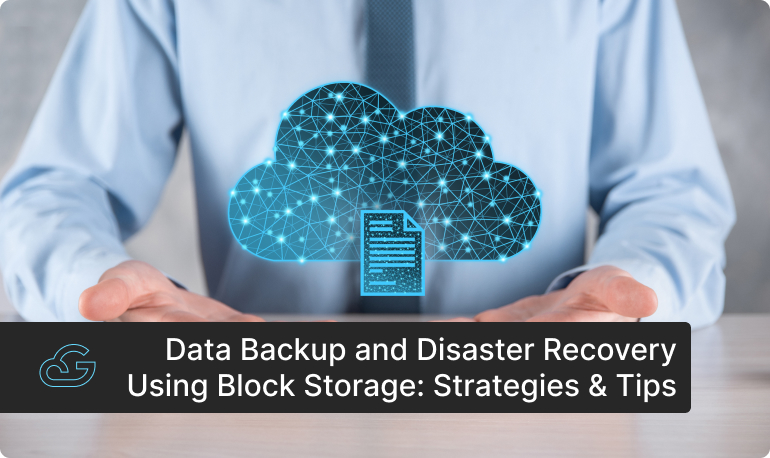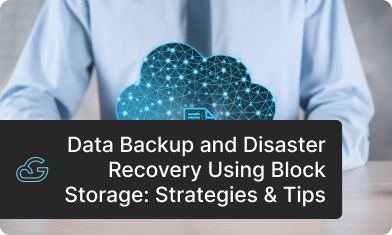Blogs / Block Storage
Data Backup and Disaster Recovery Using Block Storage: Strategies & Tips
By
Vineeth Babu
Posted: January 25, 2024
• 6 Minutes 30 Seconds
In today’s digital era, regardless of size or industry, businesses must have a robust data backup and disaster recovery plan for their most critical data. Data loss can happen in many ways—a disaster can strike at any moment, systems can fail when least expected, cyber threats are lurking in the shadows, and all humans are error-prone.
The impact of data loss on businesses is huge, so much so that around 94% of companies experiencing severe data loss never recover fully. But for businesses, setting up an effective data backup and disaster recovery framework is easier said than done. It can often be overwhelming and comes with many challenges, such as resource allocation, data complexities (volume and variety), evolving cyber threats, regulatory compliance, and high associated costs.
To overcome these challenges and streamline their data backup and disaster recovery, organizations must embrace cloud computing and cloud-based storage solutions. And one such storage solution that stands out with its performance attributes is cloud block storage. In this blog post, we will provide a brief overview of cloud block storage, explore different block storage backup strategies, and share five tips for effective data backup and disaster recovery using it.
Cloud Block Storage: An Overview
Cloud block storage is a storage system in which data is split into equally sized blocks and stored separately with unique identifiers for easy access and retrieval. Compared to other storage systems—object and file—cloud block storage comes with standout features like granular control, high I/O performance, data consistency, etc.
Even though object storage is commonly associated with data backup and recovery, there are situations where block storage may be a more suitable option. Here are some of the reasons why block storage is preferred over object storage for data backup and disaster recovery.
-
Performance:
-
Granular Control:
-
Data Consistency and Integrity:
Block storage showcases impressive performance attributes such as low latency, higher throughput, and quick data transfer rates. This is due to its block-level architecture, which allows direct access to individual blocks of data without having to parse through metadata or perform additional operations. In backup and disaster recovery scenarios that require frequent and efficient data access, block storage systems are the perfect choice.
Block storage systems operate at the block level of data. With this precise control over individual data blocks, block storage allows incremental data backups and targeted restoration. This results in numerous business benefits, such as reduced downtime and overhead, streamlined backups, and optimized backup time and storage capacity usage.
In block storage systems, data is stored in fixed-sized blocks, and each block is managed independently. That is, any change or modification to one block will not affect the other. This results in high levels of data consistency and integrity, which help create reliable data backups and enable accurate data restoration during recovery operations.
Choosing between object, file, and block storage depends on numerous factors, such as performance requirements, scalability needs, and budgetary constraints. While object storage is indeed the popular choice for data backup and disaster recovery due to its scalability and cost-effectiveness, cloud-based block storage must be preferred in backup and disaster recovery scenarios that prioritize high performance, granular control, and application-level integration.
Let’s move on to the next section and examine the most commonly used backup and disaster recovery strategies using block storage.
Backup and Disaster Recovery Strategies with Block Storage
-
Full Backup with Block Storage:
-
Incremental Backup with Block Storage:
-
Differential Backup with Block Storage:
-
Block Storage Replication for Disaster Recovery:
Full backup involves copying the entire dataset, irrespective of any changes. Block storage systems can facilitate full backup by providing access to individual data blocks. And backup solutions can read data blocks directly from storage volumes, enabling comprehensive backups
However, in a practical setting, performing a full backup with block storage can be challenging, especially with large datasets. Due to its block-level architecture, managing millions of blocks during a full backup is highly complicated, leading to unforeseen expenses in the form of management tools, additional storage capacity, etc.
Incremental backup, as the name suggests, is all about capturing and storing the data that has changed since the last backup (a full backup or a previously performed incremental backup). Block storage systems support incremental backups by allowing backup solutions to leverage the block-level architecture and capture only the changes made to the data since the last backup.
Block storage provides block-level tracking mechanisms to easily identify and transfer changed data, minimizing backup times and storage requirements. However, to fully restore the data, backup solutions must access multiple backup sets, depending on the number of backup cycles.
Differential backup involves identifying and storing all the data that has changed after the last “full backup”. Block storage systems allow backup solutions to capture changes made to data by tracking modifications at the block level. However, with each differential backup cycle, the backup set will gradually become larger.
Compared to incremental backups, differential backups require more storage space due to the aggregation of the changed data. But on the other hand, in differential backup solutions, data restoration is relatively simple.
Apart from backup strategies, block storage systems also offer replication capabilities for disaster recovery. Block storage replication involves replicating data blocks in real-time or near-real-time. This replication can occur within the same data center for redundancy or across geographically dispersed locations for disaster recovery purposes.
In a traditional disaster recovery setup, a secondary backup system is usually dedicated solely to storing data intended for restoration, without supporting production workloads due to the significant volume of data it holds. However, block storage introduces replication at the individual block level. This capability enables the secondary system to actively support workloads in a production environment, enhancing resource utilization and maximizing infrastructure efficiency.
Now that we have a clear understanding of block storage, here are five tips for implementing an effective data backup and disaster recovery framework using it.
5 Tips for Implementing Effective Data Backup and Disaster Recovery Using Block Storage
-
Utilize Block-Level Incremental Backups:
-
Leverage Block Storage Snapshots
-
Use Block Storage Replication:
-
Implement Block-Level Deduplication:
-
Adjust Block Storage Parameters:
Instead of backing up entire files, take advantage of block-level incremental backups offered by block storage systems. By breaking down data into equally sized blocks, block storage systems offer a granular view of the data and use sophisticated tracking mechanisms, such as journaling, checksums, or comparison algorithms, to identify the data blocks that have been modified since the last backup. This results in minimized backup durations, lower network bandwidth utilization, and reduced storage requirements compared to traditional full backups or file-level incremental backups.
Snapshots are a vital element of a disaster recovery framework. Block storage snapshots allow organizations to create point-in-time copies of volumes or storage volumes by capturing the exact state of individual data blocks at specific moments. With this granular access and visibility, organizations can target and restore only the data that is needed without having to perform full-volume restores, streamlining the recovery process.
Block storage systems can maintain synchronized copies of data between primary and secondary storage environments. Every modification made to the data in the primary environment is promptly mirrored in the secondary environment, ensuring both locations hold identical datasets. This guarantees real-time availability while minimizing the risk of data divergence and discrepancies.
Block-level deduplication is a data optimization practice that identifies and removes redundant data blocks within storage volumes. Unlike traditional data compression, it operates at a granular level, targeting duplicate blocks of data. By eliminating redundant data blocks, block-level deduplication significantly reduces storage space requirements. This results in substantial cost savings, especially for environments with repetitive data patterns or frequent data copies, such as data backup and disaster recovery repositories.
Efficient backup and restoration are essential for ensuring data availability and meeting recovery objectives. Block storage offers various configuration options and settings, such as block size, caching settings, network bandwidth, etc., to optimize overall performance. System admins and other users must be able to tailor these configurations based on their specific requirements and workload characteristics. For example, a larger block size can enhance throughput, while a smaller block size can improve the efficiency of incremental backups.
How Can Gsoft Cloud Help?
Gsoft Cloud’s offers robust block storage solutions that are fast, scalable, cost-effective, and secure. Our tailored solutions are integrated with cutting-edge security measures and ensure high data availability and high-speed data access, making them the perfect choice for optimizing your data backup and disaster recovery framework.
Key features of our block storage solutions are:
- Advanced security measures such as encryption, access control, and more.
- Rapid data access and data retrieval.
- Flexible configurations for changing business demands.
- Efficient data replication with snapshots.
Summary
The importance of data backup and disaster recovery cannot be overstated in the modern-day digital landscape. From unforeseen disasters to evolving cyber threats, organizations face many data challenges that will result in serious business repercussions. Cloud-based block storage emerges as a compelling solution to these challenges. With its unique characteristics and the ability to ensure high performance and data consistency, cloud-based block storage is perfect for data backup and disaster recovery.
Are you looking to implement a data backup and disaster recovery framework powered by cloud block storage? Reach out to us at www.gsoftcomm.net today.


Get Know More About Our Services and Products
Reach to us if you have any queries on any of our products or Services.










